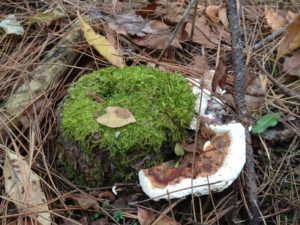By Mike Hillstrom, forest health specialist, Fitchburg, Michael.Hillstrom@wisconsin.gov, 608-513-7690
Considered one of the most destructive diseases of conifers in the northern hemisphere, HRD is very difficult to eradicate once established. Infestation of a conifer stand may significantly impact stand management, making early detection of the disease extremely important.

HRD fruit body with new white growth on infested stump. Credit: DNR Forest Health.
In fall, look for white growth both on new and previous years’ fruit bodies. New HRD fruit bodies are bright white and older fruit bodies also add new, white growth that makes them easier to detect. You may need to scrape away needles and other debris at the base of conifers to find the fruit bodies.
HRD infestation typically occurs when spores from the fruit bodies land on freshly cut conifer stumps. The HRD fungus then spreads via grafted roots to nearby conifers. When scouting for HRD, remember to check stumps from previous thinnings because fruit bodies might not show up for 3-8 years after initial infestation. Also check dead or dying seedlings and saplings for signs of HRD.
For more information about preventing HRD infestation or about Wisconsin’s HRD guidelines, visit the DNR HRD webpage.
